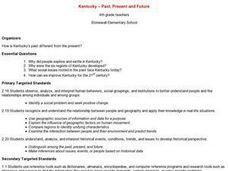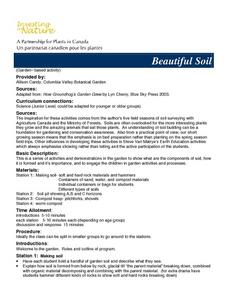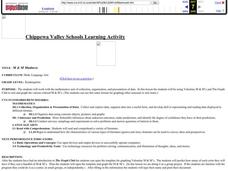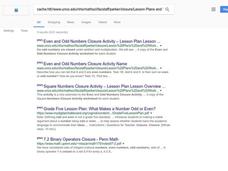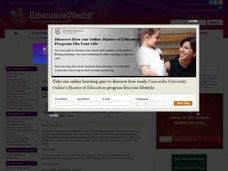Curated OER
Every Vote Counts
Students participate in an activity designed to increase student awareness and participation in the voting process.
Curated OER
Design an Island
Students explore islands. They create a two- or three-dimensional map of an island. They explain how the topography of an area influences the location of water sources, ecosystems, and human settlements. Lesson includes adaptations for...
Curated OER
Social Sstudies: Change in Space and Time
Students examine the dynamics of change and compare and contrast it with other cultures. They cite examples of how people change over time and explain why it is necessary. Students organize a skit, Webpage, or Powerpoint presentation...
Curated OER
Electricity--More Power to Ya!
Fourth graders use research tools to access and synthesize information. They gather and manipulate data using technology. Research and study the components of an electrical circuit. Create a brochure that demonstrates knowledge of how to...
Curated OER
Kentucky: Past, Present and Future
Fourth graders analyze how Kentucky's past is different from the present. They research why Kentucky was even explored and settles. What social issues face Kentucky now. Discussion lies on how Kentucky can be improved for the 21st century.
Curated OER
Is Global Warming Happening?
Students investigate the probability of global warming and the effects of global warming on the environment. They conduct Internet research and collect data, transfer the data onto an Excel spreadsheet, and create a presentation that...
Curated OER
ATP PRODUCTION
Students study four different types of ATP production and the important role it plays in normal everyday production, where ATP is formed. They will explore the role, functions and conditions that ATP is produced.
Curated OER
Beach Burgers
Twelfth graders develop economic literacy of basic economic problems confronting all societies. Economic decision making, scarcity to make choices, economic confronts, market system, prices, demand curves and supply curves are all covered.
Curated OER
Beautiful Soil
Students discover what are the components of soil. They examine how it is formed and it's importance. They engage in garden activities and processes. They hold a handful of garden soil and describe what they see. They take a...
Curated OER
Outside interview
Students refine their fieldwork skill by conducting interviews. From the position of an outsider, they conduct research and interviews. Student interviews are maintained as a part of a portfolio. Interview kits and assessment...
Curated OER
Pond Theme Unit
For this pond theme worksheet students research facts on pond life. Students complete comprehension questions, crosswords, word search, and math puzzles. Students write a short report.
Curated OER
WaterWeb
In this water worksheet, students answer 10 multiple-choice questions about the water cycle. Students also describe how they think their community is involved in sustaining water resources and write a pretend radio announcement about...
Curated OER
M & M Madness
Students work with the mathematics unit of collection, organization, and presentation of data. In this math and technology lesson plan, students use Valentine M & M’s and The Graph Club to sort and graph the various colored M & M’s.
Curated OER
Even and Odd Numbers Closure Activity
Students explore the concept of closure. In this closure lesson, students discuss what it means for something to be closed by using examples of juice and gases. Students add and multiply combinations of even and odd numbers to...
Curated OER
Breaking News English: Noise Pollution in the Oceans
In this noise pollution in the oceans worksheet, students read the article, answer true and false questions, complete synonym matching, complete phrase matching, complete a gap fill, answer short answer questions, answer discussion...
Curated OER
Collect Data Using a Transect Line
Middle schoolers learn about transect lines through a study of marine debris. In this marine debris lesson, students calculate the items on a transect line and graph them. Middle schoolers complete a category worksheet.
Curated OER
What's All the Fuss about Harry Potter?
Young scholars complete a survey to explore the popularity of Harry Potter books. In this literature and controversy activity, students examine why certain books are controversial or popular. Young scholars write original plays about...
Curated OER
Cook Me Up Some Equations
Learners study a variety of math concepts in the context of cooking up a meal. In this math lesson plan, students calculate surface area and volume. They draw and interpret different types of graphs.
Curated OER
George Lucas and the Power of Myth
Students examine the contributions of George Lucas to society. They analyze the concept of a hero, conduct Internet research on the life of George Lucas, develop a Hero Attribute Chart, and create an artistic rendering representing the...
Curated OER
Percentages, Fractions and Decimals
In this algebra worksheet, learners are asked to convert between percents, fractions and decimals. They calculate interest as it relates to real world scenario. There are 5 a,b,c questions.
Curated OER
Astronomy as a Career
In this astronomy as a career instructional activity, students use 2 graphs to answer 4 questions about the number of PhDs awarded, the number of PhD's awarded compared to Bachelor's degrees in astronomy and factors that might be...
Curated OER
Studying the Food Pyramid
Students explore the food pyramid and how to eat a healthy diet. In this nutrition lesson, students use pictures to make charts of food from the different food groups, record the food they eat throughout the day, investigate the eating...
Curated OER
Getting to Know You
Students complete a survey of interests to allow the teacher to become quickly acquainted with each student and introduce themselves using an alliterative adjective that best describes their personality.
Curated OER
Data Collection
Learners investigate qualitative and quantitative data. In this statistics lesson, students gather data on heights and weights of people and graph the distribution. Learners discuss the differences between qualitative and quantitative data.





